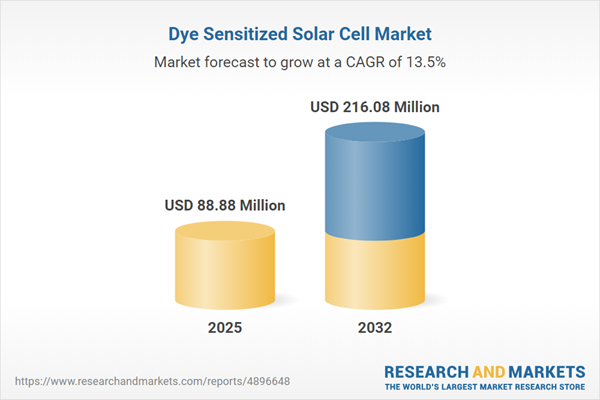Speak directly to the analyst to clarify any post sales queries you may have.
The dye sensitized solar cell market is emerging as a strategic pillar for organizations transforming their renewable energy portfolios. Senior decision-makers are increasingly considering this technology for its alignment with evolving regulatory landscapes, operational resilience, and the ability to future-proof energy sourcing frameworks across industries.
Dye Sensitized Solar Cell Market Snapshot: Growth & Technology Trends
Driven by targeted policy incentives and a rise in public-private investment, the dye sensitized solar cell market demonstrates steady development and innovation. Technical advances—including the use of quantum dots and robust solid-state designs—enhance both system efficiency and durability, supporting a wider range of industrial and infrastructure settings. Ongoing collaboration between manufacturers, end-users, and regulatory bodies accelerates the adoption cycle and assists organizations in aligning with changing standards. This environment enables businesses to diversify renewable strategies, improve operational flexibility, and reduce risk as market infrastructure evolves.
Scope & Segmentation: Comprehensive Market Overview
- Technology Types: Hybrid dye sensitized solar cells combine organic dyes with inorganic nanoparticles, enhancing versatility for deployments from commercial buildings to mobile assets. Quantum dot-based variants offer optimized energy conversion and higher precision, targeting high-performance installations. Solid-state technologies address reliability in projects where component longevity is crucial. Conventional cell types support initiatives that prioritize established engineering and risk mitigation outcomes.
- Product Types: Rigid modules deliver durable performance, making them suitable for robust industrial and commercial energy solutions. Flexible modules enable integration into consumer electronics, wearables, and smart infrastructure, accommodating new and future-ready technologies.
- Cell Components: Electrode materials such as carbon and platinum give decision-makers choices to achieve balance between cost-efficiency and high performance. Diverse electrolyte types—including liquid, gel, and solid-state—allow adaptation to a range of operating climates. Photonic active materials like titanium dioxide and zinc oxide extend deployment flexibility across substrates such as glass, plastics, and metals.
- Material Thickness: Thick film solar cells address energy-intensive operations requiring robustness, whereas thin film designs are suited to applications demanding lightweight and compact solutions.
- End Use Sectors: Automotive advances center on enhancing embedded electronics and maximizing battery longevity. In construction, the technology supports goals for smarter, more energy-efficient buildings. Consumer electronics benefit from the adaptability required for portable technologies. Off-grid and remote installations benefit by gaining consistent, standalone energy resources when infrastructure is limited.
- Applications: Application breadth ranges from grid-connected large-scale installations to modular, standalone units supporting adaptive, dynamic market and infrastructure demands.
- Regional Coverage: The Americas—including the United States, Canada, Brazil, and Mexico—lead in diversifying energy supply strategies. EMEA countries such as Germany, France, Italy, the UAE, and South Africa represent varied adoption rates and regulatory settings. Asia-Pacific regions, spanning China, India, Japan, Australia, and South Korea, present growth opportunities influenced by policy, sector maturity, and capacity for scale.
Dye Sensitized Solar Cell Market: Key Takeaways for Senior Decision-Makers
- Hybrid and quantum dot dye sensitized solar cells equip industries with adaptable renewable options for emerging infrastructure, automotive enhancements, and consumer electronics integration.
- Flexibility in module type—rigid or flexible—enables swift scaling and tailored integration into different products and upgrade cycles, matching shifting operational requirements.
- Strategic supply chain approaches focused on resilient and diversified sourcing help organizations simplify procurement while supporting business continuity during industry adjustments.
- Regulatory and governmental policies directly shape capital planning, influencing timelines for technology adoption and new solar project development.
- Strong delivery logistics underpin dependable supply to core verticals, reducing delays during market or policy changes.
- Proactive procurement strategies support organizational stability in response to external influences such as trade policy shifts or geopolitical scenarios.
Tariff Impact: Navigating Sourcing and Supply Strategies
New U.S. tariffs on photovoltaic materials have triggered a reassessment of sourcing for dye sensitized solar cells. Many market participants are migrating to domestic and regional suppliers and implementing alternatives like carbon-based electrodes and polymer electrolytes. These strategies help manage supply chain risks, restrain costs, and sustain continuous operation in volatile global trade scenarios.
Methodology & Data Sources
The analysis is based on technical reviews, peer-reviewed academic research, patent records, and real-time monitoring of regulatory developments. This methodology provides robust, evidence-backed guidance for strategic decision-making tailored to the dye sensitized solar cell sector.
Why This Report Matters
- Delivers actionable intelligence to inform strategic planning, procurement, and rapid response to regulatory changes in renewable energy.
- Maps out technology segments and regional developments to guide growth investment priorities and organization-wide risk management efforts.
- Supports executive leaders in optimizing procurement processes, investment direction, and resource deployment for enduring business value.
Conclusion
Access to targeted market intelligence enables senior leaders to make informed decisions as technological and regulatory environments evolve, supporting long-term resilience and innovation in the renewable energy sector.
Additional Product Information:
- Purchase of this report includes 1 year online access with quarterly updates.
- This report can be updated on request. Please contact our Customer Experience team using the Ask a Question widget on our website.
Table of Contents
3. Executive Summary
4. Market Overview
7. Cumulative Impact of Artificial Intelligence 2025
Companies Mentioned
The companies profiled in this Dye Sensitized Solar Cell market report include:- Greatcell Solar Limited
- G24 Innovations Limited
- Solaronix SA
- Fujikura Ltd
- Toshiba Energy Systems & Solutions Corporation
- UbiQD Inc.
- Seiko Epson Corporation
Table Information
| Report Attribute | Details |
|---|---|
| No. of Pages | 187 |
| Published | October 2025 |
| Forecast Period | 2025 - 2032 |
| Estimated Market Value ( USD | $ 88.88 Million |
| Forecasted Market Value ( USD | $ 216.08 Million |
| Compound Annual Growth Rate | 13.5% |
| Regions Covered | Global |
| No. of Companies Mentioned | 8 |









